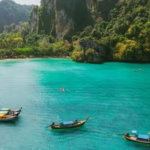Unexplored Places in India That Should Be on Your Bucket List
Introduction India is globally known for its iconic destinations like the Taj Mahal, Jaipur’s palaces, the backwaters of Kerala, and the beaches of Goa. But beyond the tourist maps and camera flashes, there lies a different India—one that’s raw, untouched, mystical, and deeply authentic. This India lives in its hidden valleys, isolated islands, tribal hamlets, and mountain passes. This blog is a curated journey through some of the most unexplored places in India that are waiting to be discovered. These destinations promise peace, adventure, cultural immersion, and stories you won’t find in guidebooks. Why Explore Unexplored Places in India? 1. Escape the Tourist Crowds While popular destinations offer convenience, they often lack the serenity and connection that many travelers seek. Unexplored places provide a sanctuary away from bustling crowds, giving you more space to connect with nature and local life. 2. Authentic Cultural Experiences In these hidden regions, traditions are preserved, languages are unique, and people live in harmony with their land. The cultural immersion you get here is unfiltered and often untouched by commercialism. 3. More Affordable and Less Commercialized Traveling to lesser-known destinations is not only lighter on your pocket but also offers better value. Local accommodations, food, and experiences are more budget-friendly and support community-based tourism. 4. Responsible and Sustainable Travel Tourism can strain resources and environments. Offbeat travel allows you to tread lightly and explore responsibly, spreading the economic benefits to areas that need it most. Hidden Gems In India Northern India’s Hidden Gems Zanskar Valley, Ladakh Why Visit? A jewel in the Himalayas, Zanskar Valley is a remote, majestic land with dramatic landscapes, ancient monasteries, and thrilling adventures. It is the perfect place for trekkers, spiritual seekers, and nature lovers. Highlights: Best Time to Visit: June to September (accessible), January-February (for the Chadar Trek). Tirthan Valley, Himachal Pradesh Why Visit? Nestled near the Great Himalayan National Park, Tirthan is a nature lover’s dream. With trout-filled rivers, hiking trails, and tranquil villages, it’s a peaceful retreat from the world. Activities: Ideal For: Couples, solo travelers, digital detoxers. Chopta, Uttarakhand Why Visit? Known as the “Mini Switzerland of India,” Chopta is a lush meadow offering panoramic views of the Himalayas. It’s also the base for treks to Tungnath and Chandrashila. Highlights: Unexplored Places in North-East India Dzukou Valley, Nagaland Why Visit? A scenic wonderland between Nagaland and Manipur, Dzukou Valley is known for its seasonal blooms and trekking routes. It’s one of the most pristine landscapes in Northeast India. Best Time to Visit: June to September for flowers; October-November for pleasant treks. Experience: Camp under the stars, hike through rolling hills, and discover wild lilies. Majuli Island, Assam Why Visit? The world’s largest river island, Majuli is a cultural and spiritual hotspot in the Brahmaputra River. It is the center of Assamese Vaishnavite traditions. Highlights: Ziro Valley, Arunachal Pradesh Why Visit? Home to the Apatani tribe and famous for its music festival, Ziro offers a unique blend of nature and culture. The lush rice fields surrounded by pine-covered hills are a photographer’s dream. Best Time: September (Ziro Music Festival), March-April for spring blooms. Western India’s Hidden Treasures Bera, Rajasthan Why Visit? Tired of tiger safaris? Head to Bera, a lesser-known haven where leopards roam wild amidst granite hills. It’s also home to the Rabari herdsmen, offering a cultural blend. Highlights: Patan, Gujarat Why Visit? An ancient fortified town with UNESCO heritage, Patan is renowned for Rani ki Vav, one of India’s finest stepwells, and Patola silk weaving. Must-Do: Central India’s Lesser-Known Destinations Chanderi, Madhya Pradesh Why Visit? Chanderi is a historical town with deep roots in Rajput and Mughal history. It’s famous for its handloom sarees and architectural ruins. Highlights: Orchha, Madhya Pradesh Why Visit? A sleepy town with grand cenotaphs and riverfront palaces, Orchha blends history, spirituality, and scenic beauty. Activities: Southern India’s Unexplored Wonders Gokarna, Karnataka Why Visit? Often dubbed the peaceful cousin of Goa, Gokarna offers untouched beaches, temple town charm, and cliffside views. Best Beaches: Araku Valley, Andhra Pradesh Why Visit? Surrounded by dense forests and tribal hamlets, Araku is known for its coffee plantations and scenic train route. Don’t Miss: Agumbe, Karnataka Why Visit? Known for its rainforests and high rainfall, Agumbe is a biodiversity hotspot, also called the “Cherrapunji of the South.” Highlights: Island and Coastal Hidden Gems Kalapathar Beach, Andaman Why Visit? Located near Havelock Island, Kalapathar Beach is serene, scenic, and largely free of tourists. Ideal For: Solo travelers, couples, beach picnics. Varkala, Kerala Why Visit? Famous for its cliffs adjacent to the Arabian Sea, Varkala combines spiritual healing with surf, yoga, and Ayurvedic retreats. Activities: Tips for Traveling to Unexplored Places 1. Connectivity & Transport These regions may have limited transport. Always research local buses, shared taxis, and the nearest railway station or airport. 2. Accommodation Homestays and eco-lodges are more common. They offer a chance to live with locals and enjoy homemade food. 3. Cultural Sensitivity Learn basic local phrases, respect dress codes, and avoid littering or damaging natural surroundings. 4. Essentials to Carry Conclusion India’s most unforgettable travel stories are often born far from the typical trails. From the snow-laden heights of Zanskar to the tribal valleys of Ziro, and from coastal Varkala to the wild hills of Bera, these unexplored places promise experiences that are immersive, soulful, and transformative. If you’re craving something more than a vacation—a journey that changes how you see the world—then pack your bags and take the offbeat path.









